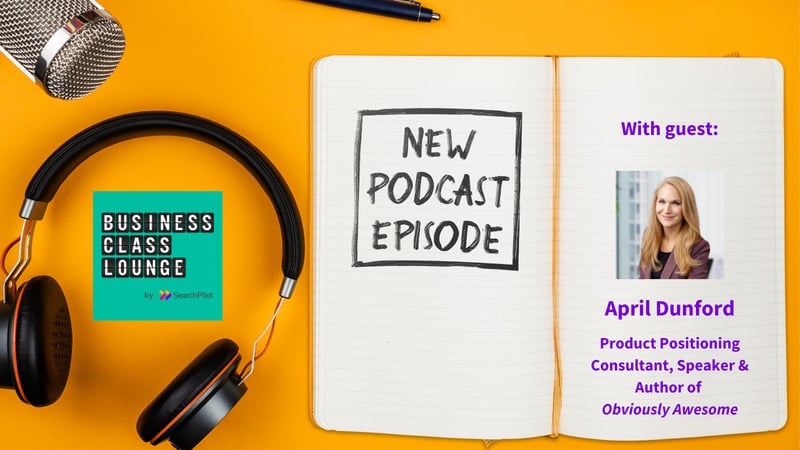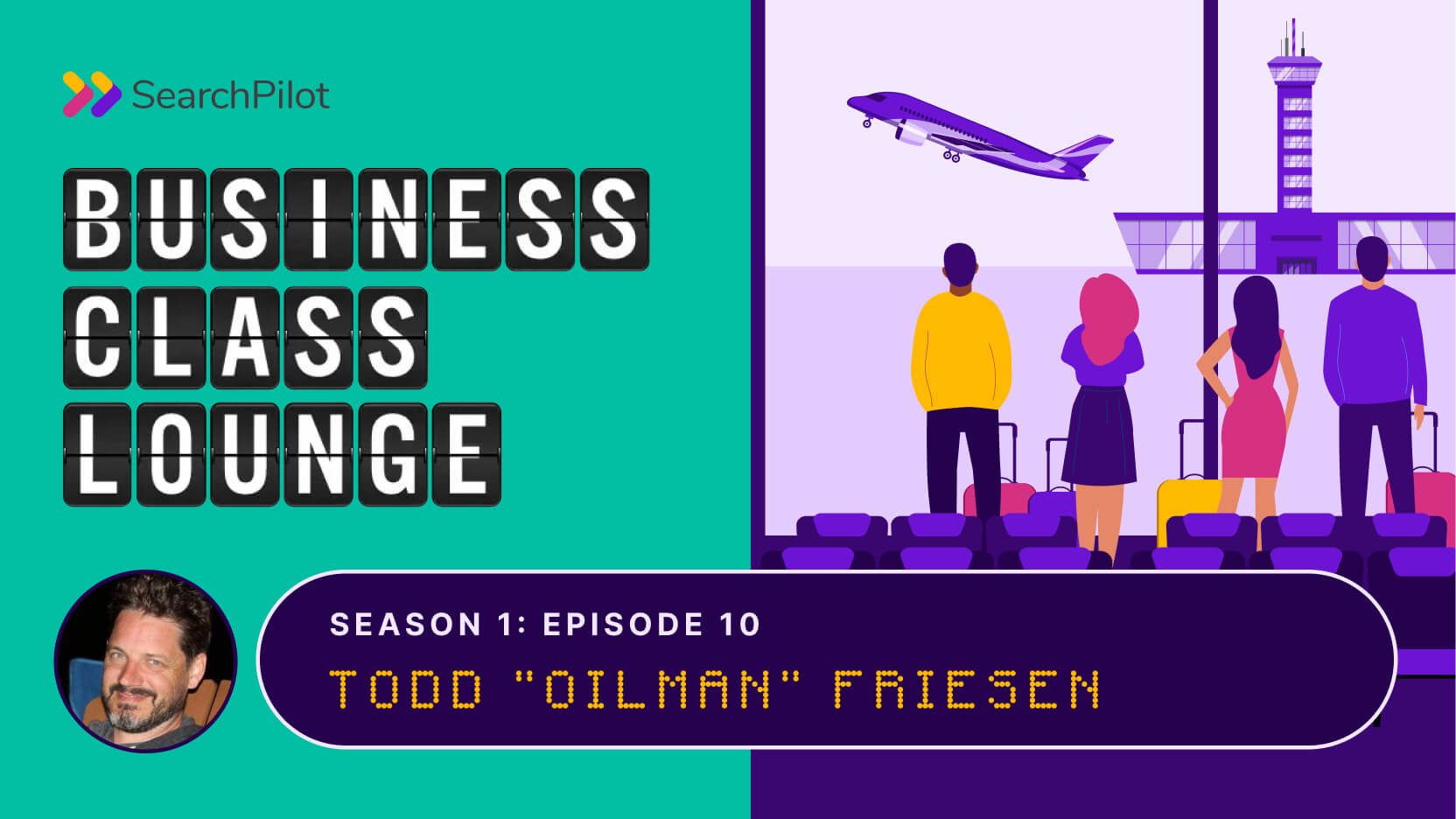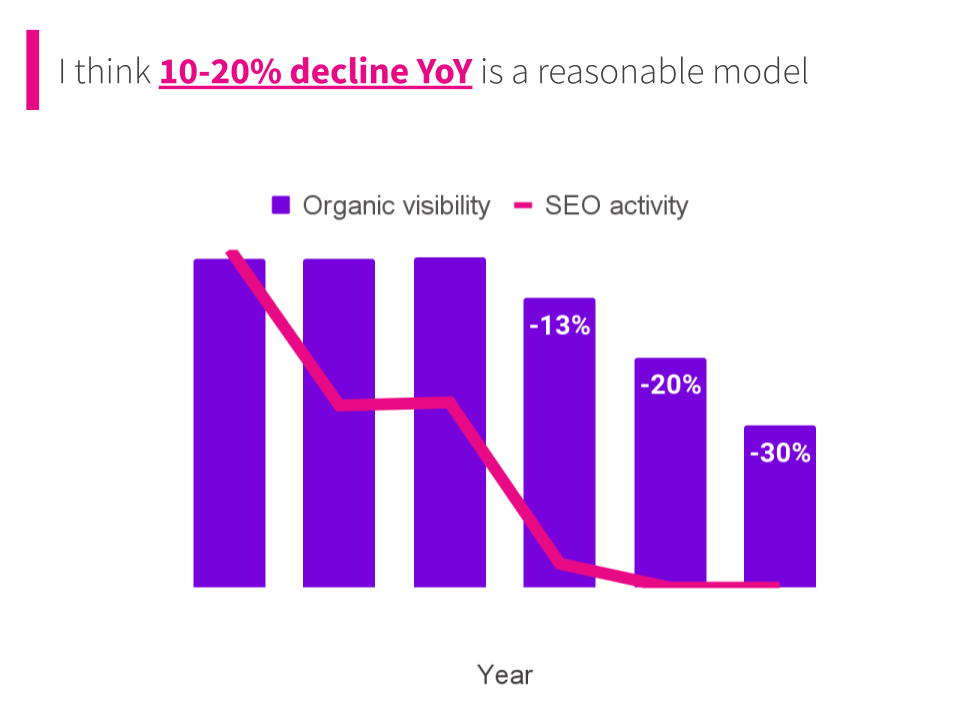My guest for Episode 6 is the author of the book ‘Obviously Awesome’ and is the best book I know of on positioning. I know many of you will have read it, and if you haven’t, I highly recommend that you do. April Dunford is a well-known author and consultant. She’s also held senior marketing leadership positions at a range of startups and big well-known companies. She’s done a million interviews about positioning, so I wanted to pick her brains about some different things. She shared a lot of anecdotes, so I’ve published an abridged version of the transcript here. To listen to the full episode, just hit the play button below.
How should a CMO or a VP of Marketing think about how to persuade a board or a CEO or whoever needs to sign off on a budget that they should do a big positioning exercise?
April Dunford (AD): First of all, I think about positioning as being the underpinning of almost everything we do in marketing and sales. It’s a fundamental input. If you came to me and said, “April, we gotta run some campaigns.” I go, “Great, let’s run some campaigns, man. Let’s figure that out.” First I need to know who’s our target for the campaigns and what’s our value proposition. Who are we competing against and why pick us versus the other guys? All this gets defined in your positioning.
If that positioning is garbage, then all my campaigns are garbage. That’s how it works.
The same thing goes for what we’re doing in sales. If the story we’re telling in sales is garbage, then we don’t sell very well, or we don’t sell as much as we could. And the input for that story is: why pick us versus the other guys, which is essentially your positioning.
I came to the conclusion, as a repeat Vice President of Marketing back when I was working inside companies, that my job is to step on the gas and drive a whole bunch of leads so that sales can close them and we can grow revenue. But if I’m doing that with squishy positioning, there’s no point in even getting it done. We have to back all the way up and work on this positioning. It took me a while to figure that out, but once I did, I was more: “We really don’t want to get started on campaigns and messaging and all this other stuff we’re gonna do until we get the positioning right now.” Like you said, not everybody knows that or thinks like that.
If my positioning is weak, it’s killing me across all my metrics in a way that I can’t just measure. I can’t just say, “Oh, our conversion rate is this and that’s bad.”
If the positioning is weak, then it means bad leads are coming in because they don’t really know what you are.
They drop out as they come through your funnel because then they do figure it out and they’re like, “Oh, that’s not what I want. I’m dropping out, or I shouldn’t have been in here in the first place.”
My focus area has always been B2B. I come in as the brand new VP of Marketing, and usually at the beginning, they’re going to give you a few weeks to get your feet under your desk. Here’s what I would do, I would wander over to sales and listen in on sales calls. If it’s going well in sales, then the story works. You could assume that the positioning works. If it’s not going good, then what I would do is I would go have lunch with the VP of Sales to talk this through. Then I’d have the same lunch with the Head of Product. Now I have the Head of Sales and the Head of Product, I then go to the CEO and say, “Look, I want to build all these nice campaigns and stuff that you want, but I’m worried this story is squishy. If we build all these campaigns on this squishy story, that’s a waste of money. I was hanging out with sales, and here’s what I’m hearing. I’m not saying it’s bad, but I think it’s worth spending a day or two getting the team together and we’re going to revisit the positioning and let’s just see where we get to.”
The reality is if I had lunch with sales and the guy in sales says, “No, you’re wrong,” Then maybe I’m wrong, I’m brand new. Then I have to go back to the drawing board. But if sales says yeah, and product says yeah, then I use that to go and talk to the CEO. If I just go straight to the CEO and I can’t convince sales and product, then what’s the point of even doing this? I’m not gonna be able to make this new positioning stick anyway. And the other thing is that if we’re going to do positioning well, it’s got to be a cross-functional effort.
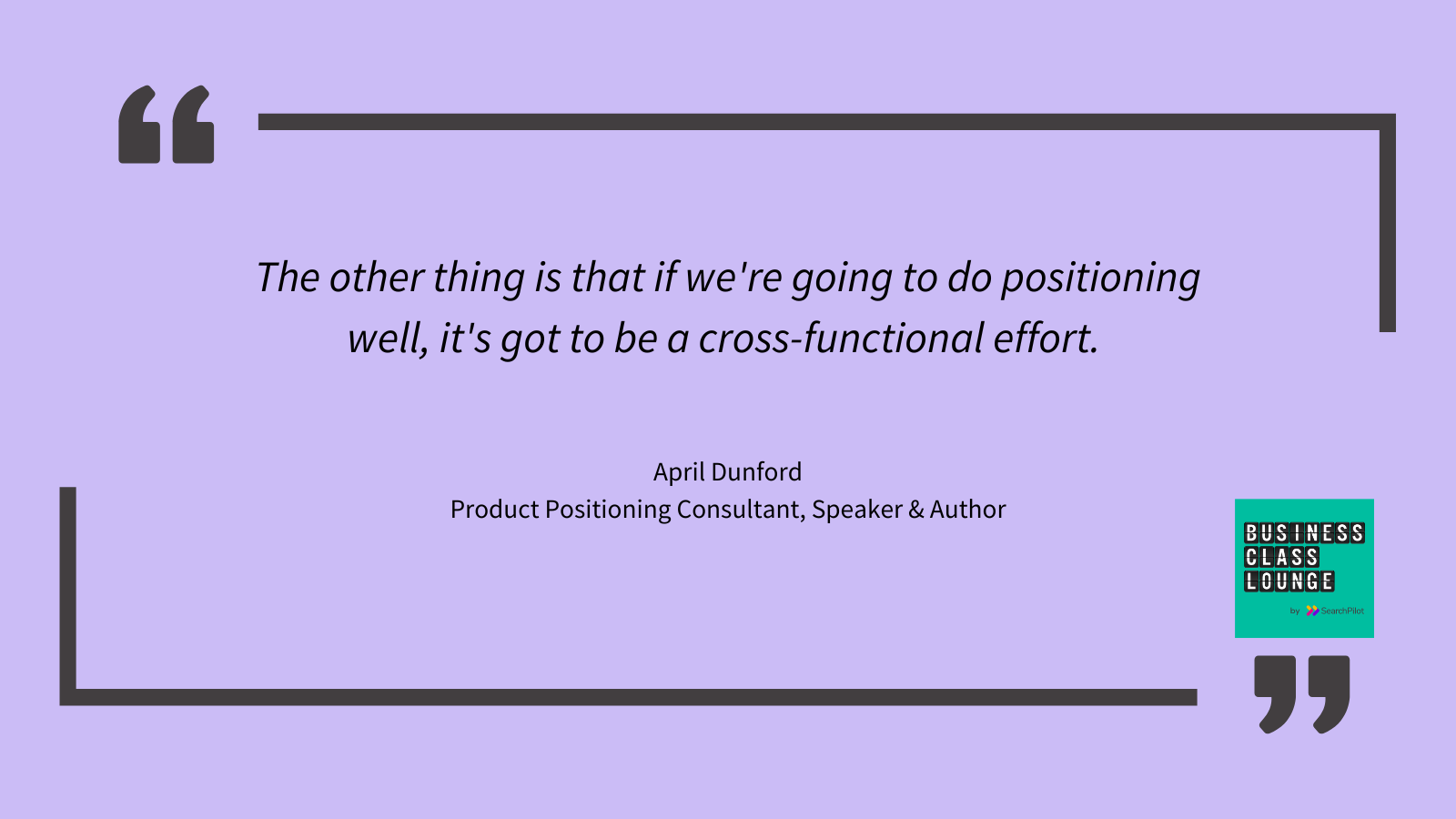
Getting people to talk about the squishy positioning is one thing, but the scale of executing this stuff is another. Can you share how you do this?
AD: I’d get a cross-functional team together and we’d spend max two days. I’ll get sales, product, customer success, and senior executive team in together. Then start with:
Competition:
- Who do we have to beat in order to win a deal?
- What do I have to position against?
There are two kinds of competition. There’s whatever status quo, and sometimes that’s a spreadsheet or manual labor. But then there’s also anything that lands on a shortlist that is against us. That’s what I have to beat in order to win a deal.
Features:
- What do we have that they don’t have capabilities wise?
- For every one of those features, so what?
- Why does a customer care about this feature?
What we need to do then is translate the feature into value. Now that assumes we understand what’s valuable and what isn’t with our customers. Generally, if companies in the market have sold a reasonable amount, they actually do know that since they’re selling every day. We want two or three points of value and not thousands of points. We’re looking for the themes, like what are the value themes we enable? If we do it that way, by starting with what we have, what we have got to beat, and what we have got that’s different, we then translate that into value. And now, we don’t just have value, we have differentiated value. We have the value that we can deliver, that the competitor can’t.
Then the next step, and this is critical, is, “Okay, this is the value I can deliver that nobody else can. Who cares? I’m not the best fit for everybody and every company on the planet. What are the characteristics of a target account that make them really care a lot about the value that only I can deliver?” And so now I’ve got, here’s my differentiated value, here are the people that I can sell to.
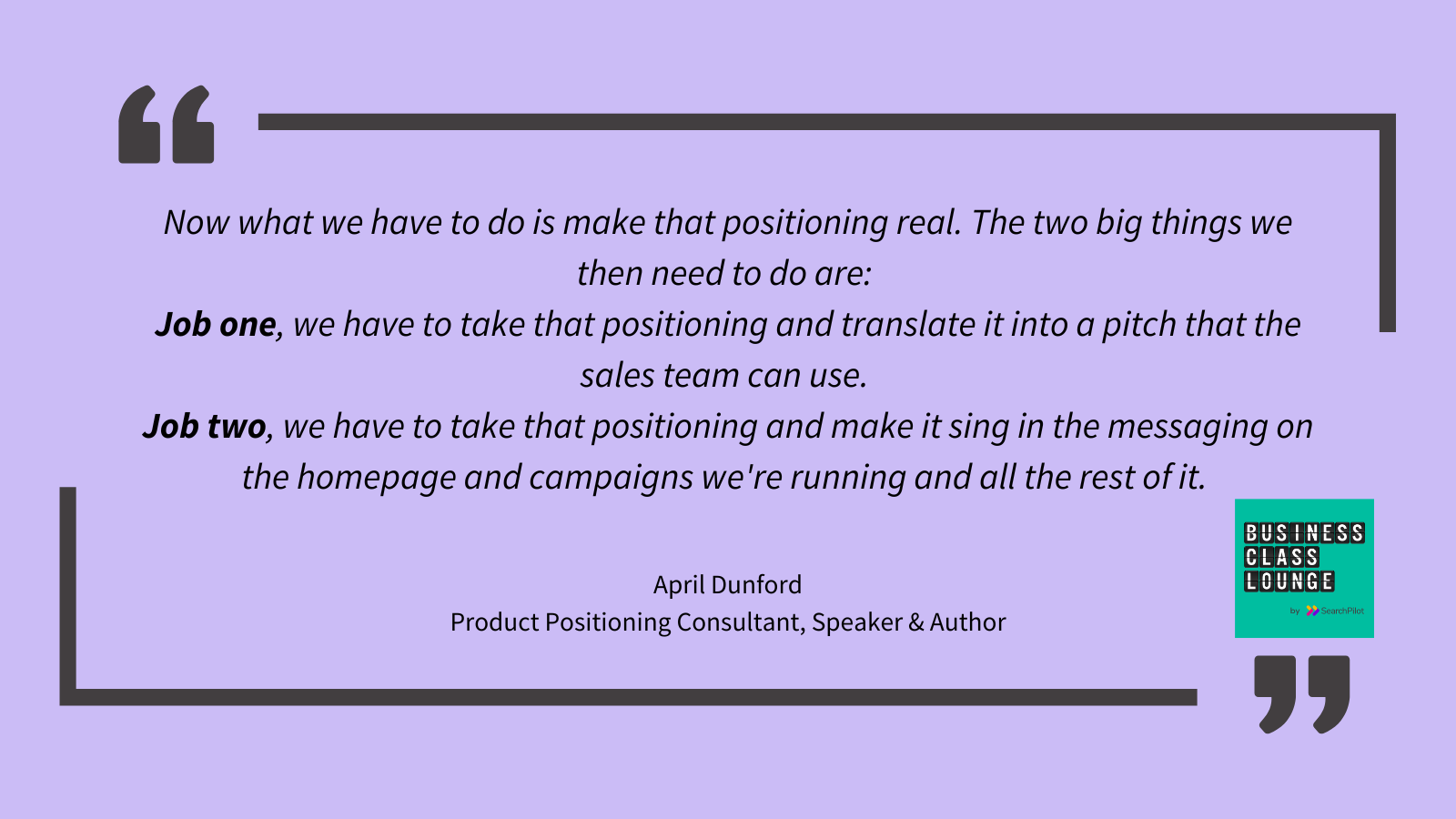
Sometimes when we do this exercise, we get to this point, and then the list of people that we can sell it to doesn’t seem like a very long list of people. That’s the oh shit moment where you’re like, we need to fix something in the product. But for the workshops that I’ve done, and I’ve done a couple hundred of these, usually when we get there, we find there’s a huge chunk of the market where we can win. And the company is actually doing the opposite, they’re trying to sell in all kinds of places where they can’t win. But meanwhile, there’s this chunk of the market that is more than big enough to meet the short-term revenue goals. But instead of just focusing on that, they’re focusing on everything. And so as a result, they’re fighting for deals that they’re never going to win or that they shouldn’t win and wasted a lot of marketing effort on parts of the market where they don’t actually have a distinct advantage. What we want to do is to identify where we should win and where we win because we got value that the other guys can’t deliver. Then let’s focus all our marketing and sales energy on that. We can do an exercise like that and get it done in a day and a half. Now, we have everybody (product, sales, customer success, executive team) in alignment on:
- Here’s who we compete with
- Here’s how we’re different
- This is the value we can deliver and no one else can.
- These are the people that really care a lot about that value.
Now what we have to do is make that positioning real. The two big things we need to do:
Job one, we have to take that positioning and translate it into a pitch that the sales team can use. In my opinion, that’s job one. Because if sales can’t tell that story, we’re dead very quickly.
And then job two, we have to take that positioning and make it sing in the messaging on the homepage and campaigns we’re running and all the rest of it.
If everyone’s in agreement, It’s easy as heck to go build messaging around that. Trickier part though, and the part that I think people don’t spend enough time on is we have this positioning, how do we make sure sales knows how to pitch?
So your next book is all about that - implementing the positioning into the sales messaging and into the sales teams. Can you give us a sneak preview? What’s the high-level thinking on that?
AD: I started out doing just the positioning bit, and then we’d end there. But then I would call the company three months later, marketing’s all happy but sales don’t know what to do with this. Sales intellectually understands the positioning, they just don’t know how to pitch it. When I wrote my first book, there’s one page where I was like, “Hey, you know what’s a good way to test your positioning? You should turn it into a sales pitch and pitch it to some people and see if it works.”
Over in marketing, we’re trying to weave the story about how we’re different, and our differentiated value is all this. Then the customers get into the pitch and sales is showing everything like it’s equal, whether it’s differentiated or not and the value of that is up to the customer to figure out. We just assumed the customer’s going to do that translation between feature and value. The thing we are fundamentally not answering in those meetings is “why pick me over the other things”. That is the only reason a person is in that sales meeting in the first place. We think the customers already have all the answers and all they want to do is look at our beautiful UI or something. But this is the problem if you’re in a crowded market and the customers are looking at three other competitors that look just like you. It’s a lot of burden on the customer to try and figure out why your stuff is different. Why should they pick you?
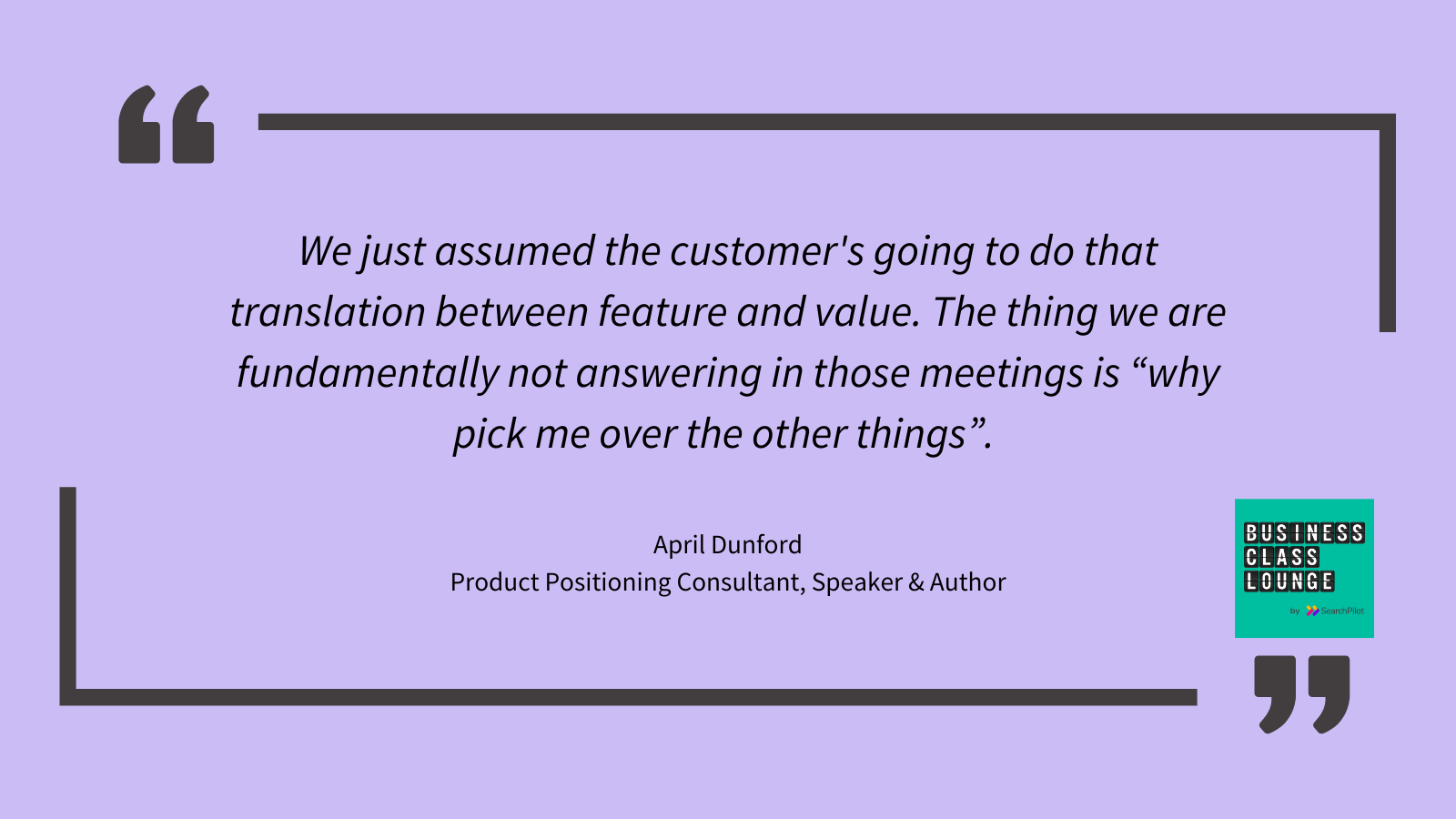
I do this with my clients now. Because if I don’t, we’re in trouble. We do the whole positioning thing and then we spend the last three or four hours taking that positioning and translating it into a sales pitch. So the book I’m working on now is, how do you do that? What’s the structure of a sales pitch? How do I take this positioning and map it into a sales pitch? How do we do a good job of answering the question, why pick us, in that sales pitch? Why should a company like you pick us versus all the other things that you could potentially pick?
In the course of writing this book, I’m digging through the data on this and it’s terrifying. The data says that in a typical B2B purchase process, 40-60% of B2B purchase processes start with “we said the thing we’re doing now sucks. We want to go buy something else.” We go through this process and we look at alternatives. Then that purchase process ends in no decision and then you scratch at that data a little bit more. Why is there no decision?
The reason they end up a no decision is they can’t figure out how to confidently pick a solution.
In B2B, the economic buyer, who is the person that signs the check, is usually not the person that does the evaluation. The VP says to somebody in their team to go buy an accounting software or something. That person has to run around, look at all the vendors, look at the stuff, talk to it, talk to the end users, and then come back with a recommendation, and then the boss is going to sign off. That person is under a lot of stress. If they make a bad choice, bad things happen. If I go out there and do a bunch of these demos and look at stuff and say, I can’t freaking figure out why I would pick one versus the other. The easiest, lowest risk decision is to go back to your boss and say, “You know what? Let’s just not do it now. Let’s just kick the can down the road. We’ll decide next year. We’ll go look next year. We’re in the middle of an audit.” There are a thousand reasons.
What we actually want to answer in the sales meeting is we have to paint a picture of the whole market, show where everybody fits in the market, and then give them a compelling pitch for why companies like you want to pick us for these reasons. And by the way, “that’s not why you would pick them. Not that they’re bad, they’re good for other kinds of customers, but a customer like you needs this.”
The data on this is also really interesting. It shows that what a software buyer wants in a sales process are these top two or three things:
- They are all about understanding the market.
- They want to understand their alternatives. The pros and cons of the different alternatives.
- They want to be able to avoid landmines. How do they make sure they make a good choice?
Basically, it’s like context-setting for your differentiated value. If you could think about it at a very high level: here’s why we built what we built, because we see this happening in the market for customers like you and nobody else sees that. That’s why we have a thing that nobody else has. If you can do that, then you can really clearly establish a differentiated value.
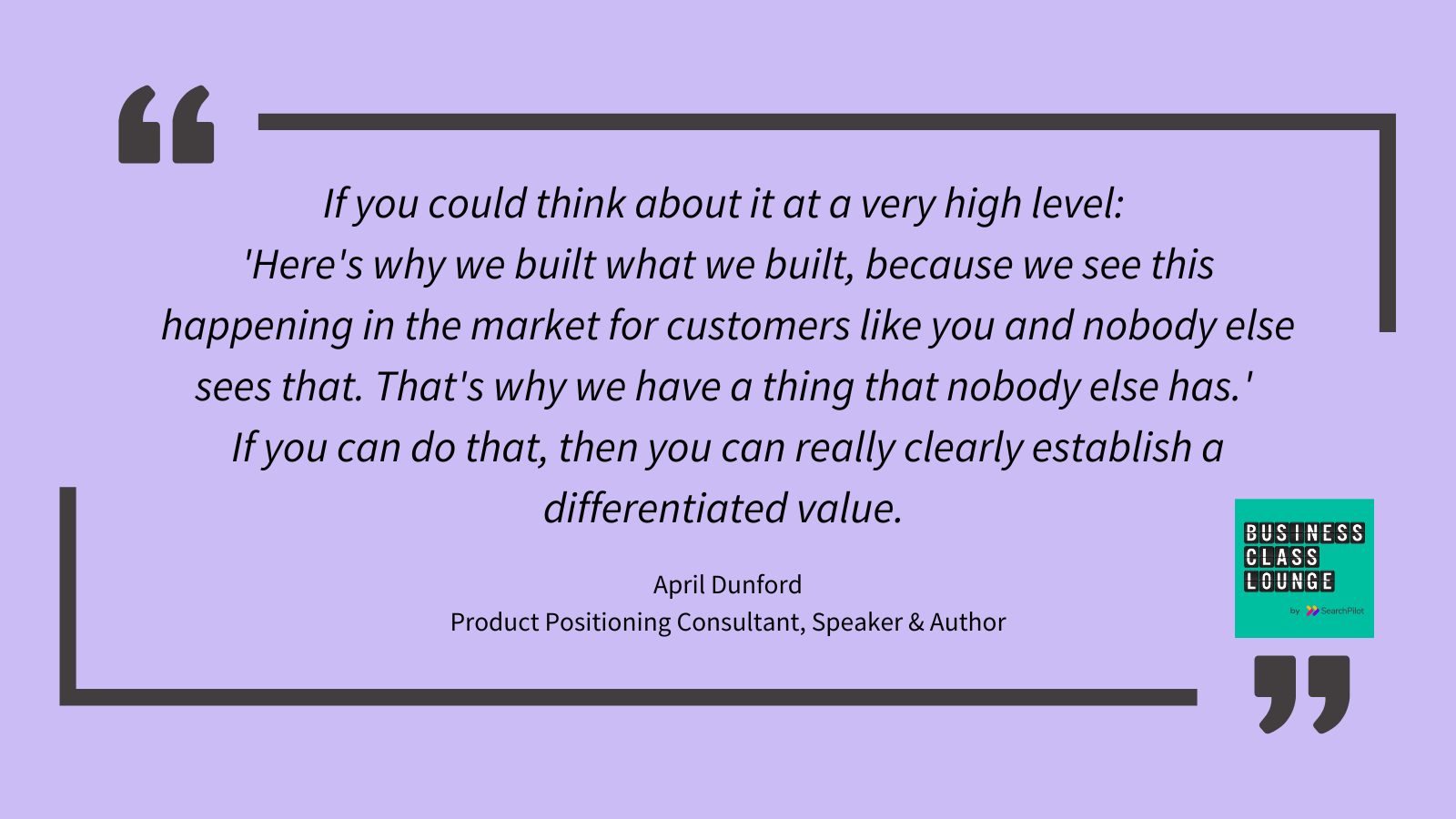
You’ve talked a bit about the difference between the champion and the economic buyer and those kinds of things. What were those dynamics in the vendor onboarding process when you were at that senior level at Nortel or IBM or similar places where there are all these different stakeholders? Can you share some great insights?
AD: In general B2B purchase process, there are five to eight stakeholders at least involved in the deal. So you’re not selling to one person, you’re selling to eight people and all this stuff, but that’s only kind of true. Typically what you have is you got a champion, right? Because the champion is the person that either has taken on the task or has been tasked with making a recommendation.
One of the mistakes I think we make in B2B is we think that our job is to sell to all the stakeholders, and the champion is just one of the stakeholders.
So I have to have positioning for all of these other stakeholders, and I think this is a way to drive yourself absolutely crazy and never sell anything. Instead, what I think you’ve got is you have the champion. and the champion matters times a million versus all the other roles. Frankly, if your positioning doesn’t resonate for the champion, you don’t get on a shortlist. None of the other people matter because you never make it to any of the other people. The second thing is that typically we, as the vendor, are not selling to all the other stakeholders. The champion is selling to all the other stakeholders, so really our job is to sell to the champion.
Once we have the champion hooked, and a deal is cooking, our job is to arm the champion to handle all of the potential objections of the other stakeholders.
In the work that I do with positioning, we’re really focused on this champion. What I see in companies is they’re spending a lot of time doing persona work and all this stuff for all the other personas, and they’re treating the champion like just one of six. Meanwhile, the champion matters like times a million. It’s not like the other ones don’t matter; they do. But you have to work through the champion. We’re not directly messaging the end users because they have nothing to do with making this deal happen. But you have to understand their objections. All we really need to know is what their objection is and how we arm the champion to handle it.
When you look back over your career, what do you think were those breakthrough moments or great bosses, bad bosses, great mentors that made you think that really made a difference?
AD: How I even got into tech was just good luck in a lot of ways and a friend of mine helping me out. I got a job at a startup out of engineering school, and they hired me in product marketing. I got the job because my friend worked there and put in the word for me. But the first thing we worked on was this positioning thing, and we had no idea what we were doing. We were just monkeying around till we got it and we got really lucky. We got something that worked. The thing was a rocket to the moon, and then we got acquired. Then I had this big fancy job at the big company and inherited a bunch of products and that got me really interested in positioning because I’d had that early success at it even though I didn’t know what the hell I was doing. That got me down the whole rabbit hole of how we should have done this. What were we supposed to be doing? That led me down a path to do that, and then I ended up repositioning a couple of things at the new company, and that worked out pretty good. That became my jam.
One of the things I didn’t plan on doing was that I bounced between big companies and small companies in the early part of my career. Not by choice because I was working at little companies that were getting acquired but I thought that was really good. I learned a lot by seeing the contrast between ‘this is how we do it at a small company’ and ‘this is how we do it at a big company’. A lot of marketers I see will work at one job and they’ll be like, okay, this is how it’s done. Oh you wish , but no, every company’s different. You do a few of these back and forth between big ones and small ones and you get an idea of how to start figuring out what you don’t know. And that I think is really important.
After I came out of the last VP role I thought to myself, am I really gonna do this again? I then thought maybe I’ll just do something different and switch to consulting. That was a whole journey too but fun. It was a lot different than I thought it would be. It took me a long time to figure out what’s my offering and then who do I see that’ll be a really good fit for that offering. How do I position this thing for these people? At that time, nobody was out there looking for positioning help. They usually have a problem with marketing or messaging or something else. Nobody even knows what positioning is and I’m trying to sell this thing. So that’s been really fun too. I didn’t see this in my future, but now that I’m here, I’m like, ah, I should have been doing this sooner.
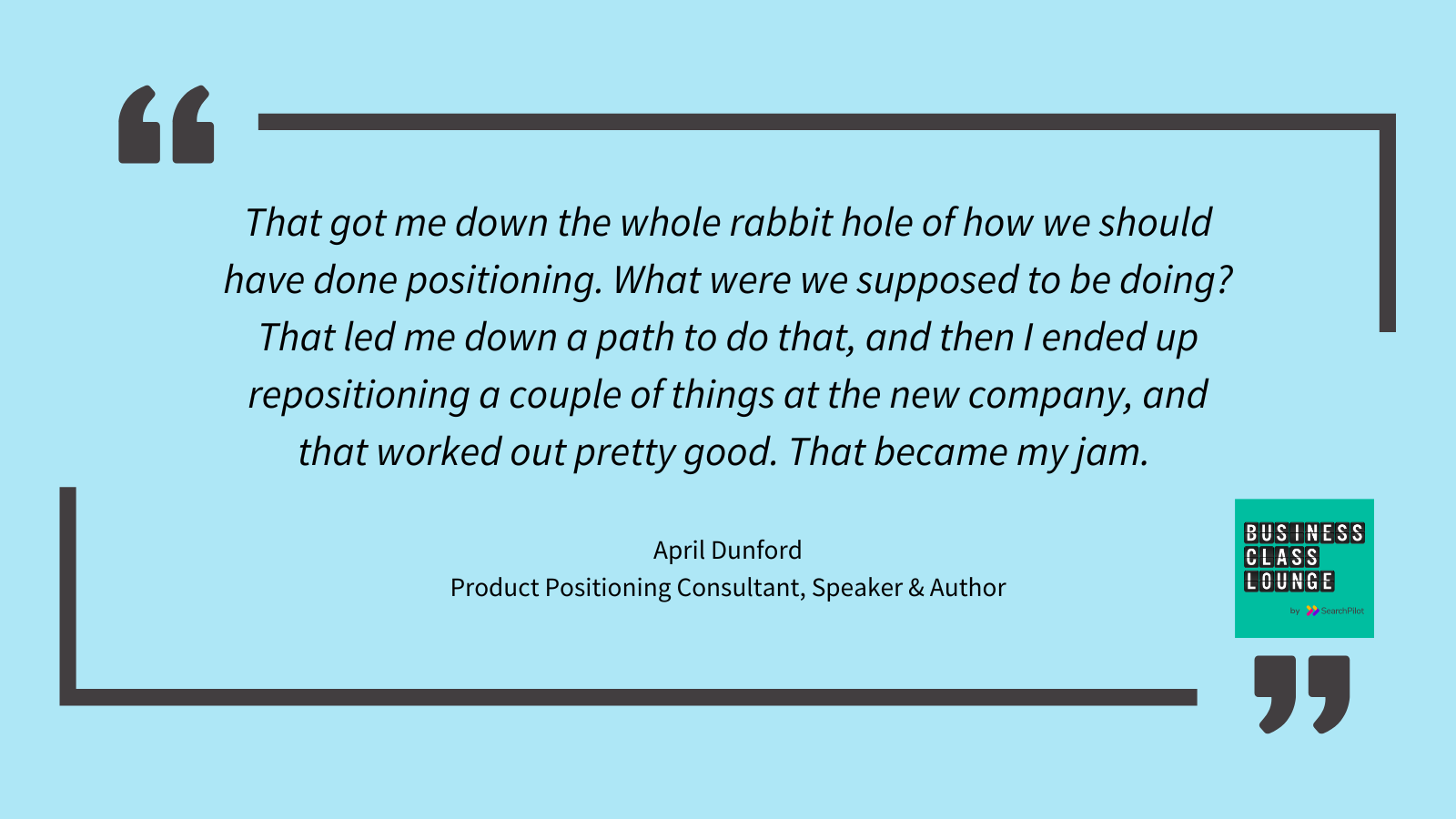
How do you keep improving? How do you stand off of your game? What do you read, listen to or watch?
AD: This was easier earlier in my career. When I started, I didn’t have a marketing background. I felt in the early part when I was in marketing, that everybody knows all this stuff and I don’t know shit. I read everything and I took courses; tons of courses. I went and did all this post-grad stuff in marketing because I had this feeling that I was behind. I did a lot of that in the first 10 years of my career. If I wasn’t working, I was trying to figure out something, and literally read all the books, subscribe to all the blogs and all that stuff.
It gets harder when you get more senior because there’s a lot of stuff that you already know. You’re trying to find this cream of stuff that you don’t know so that you can keep growing. Occasionally something pops up that’s like, holy shit, there’s a whole bunch of stuff in here that’s amazing. The guys that wrote Challenger Sale and Challenger Customer, I appreciated those books because they were based on this deep longitudinal research. The guy that wrote the Challenger Sale, one of the guys, his name is Matthew Dixon. He just came out with this book called The Jolt Effect. This is the best book I have read in a while, and it’s really a book about sales. If you’re in B2B, you’d be crazy not to read this book. What they did was, at the start of the pandemic they worked with a company and they went out to a whole bunch of companies that they were working with. They analyzed their Gong recordings then they did this AI machine learning model to see what works and what doesn’t work on a sales pitch. The results are in this book and are super, super fascinating.
Further links
There are more great discussions like this, so head over to wherever you get your podcasts on Apple, Spotify, Amazon, YouTube or you can catch the full episode directly from the feed here.
I’d love to hear your thoughts on this fifth episode, email me at podcast@searchpilot.com or send me a message on LinkedIn. You can also find April on LinkedIn and check out her book, Obviously Awesome and her work on positioning.
